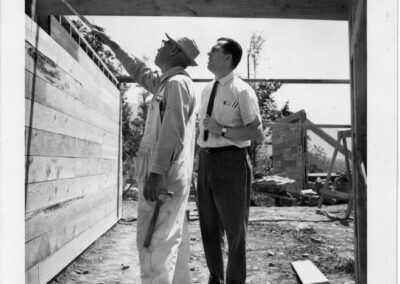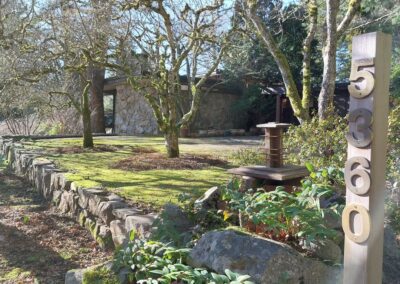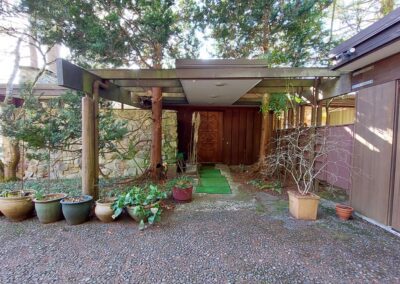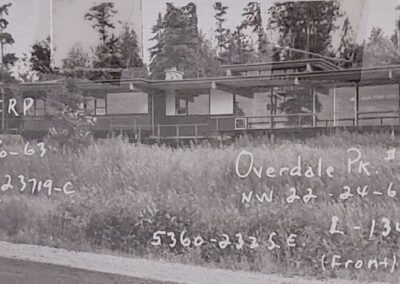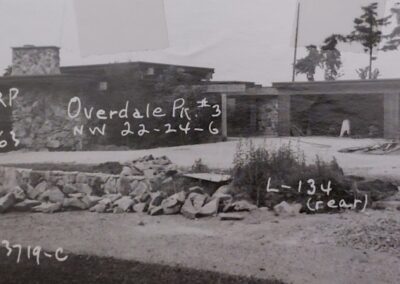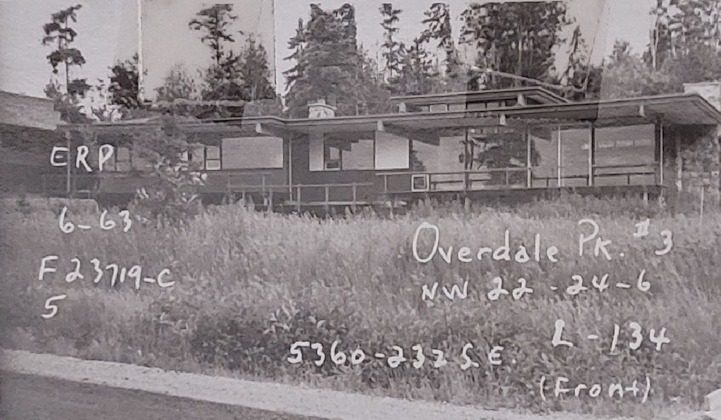
Wenberg House
Built 1963
The content below is from a 2023 City of Issaquah Landmark Registration Form by Sarah J. Martin.
The History
The Johan and Louise Wenberg House, named for its original owners, is significant for its strong associations with mid-20th century patterns of community planning and development, as well as its excellent reflection of the Northwest Regional Style. It is located in the 1960s-era Overdale Park neighborhood, a planned residential subdivision of approximately 120 acres that was only annexed into the City of Issaquah in 2000. Completed in 1963, the Wenberg house occupies a sprawling hilltop lot with a southwest view of the Issaquah Valley. The residence’s impressive post-and-beam structure, expansive glass walls, and passive solar design are notable and reflect the work of architect Omer Mithun and builder Gustav Bruse, as well as the contributions of the Wenbergs themselves.
Johan, a medical doctor who graduated from the University of Washington School of Medicine’s first class in 1950, and Louise, a librarian and 1947 UW graduate, were among the first to purchase and develop lots in Overdale Park. The Wenbergs kept detailed records of their expenses, which provide important insight into their decisions as well as timeline of the property’s design and construction. In keeping with the property’s covenant requiring an owner to “remove all alder trees” within a year of purchase, the Wenbergs had it bulldozed and cleared. By early 1961, architect Omer Mithun was consulting on the design. In April 1962, Johan Wenberg obtained a building permit from King County Engineer’s Office to construct the residence.
Gustav Bruse, an Edmonds-based builder and Louise’s father, was the primary builder. Louise recalled, “My father did absolutely all of the carpenter work.” He had assistance from Ivar Johnson and other craftsmen. Stone masonry work was completed by O. Isaksen, T. O. Beckman, Loren Holmberg, Bob Barker. For the most part, construction materials were sourced locally. Much of the home’s lumber came from the Tanner Mill in North Bend, and, as previously mentioned, the Wenbergs collected stone from Snoqualmie Pass near Surveyor’s Lake.
The Wenbergs themselves contributed in tangible ways to the construction of the residence. Johan worked closely alongside Bruse during construction, as did Louise who recalled, “I dipped all the siding of the house, garage, and deck in a solvent one summer.” Notably, the cedar double doors at the primary entrance feature Northwest Indigenous-inspired carvings made by Johan. Louise picked out all the home’s fixtures and interior finishes. The couple also put considerable effort into the outdoor areas surrounding the house. Appearing on the expense list are ten payments totalling nearly $1,000 to landscape architect Richard Haag, between April 1963 and September 1966, when he was also working on adaptive re-use plans for Seattle Center. While Haag’s involvement is noteworthy, his ultimate influence on the Wenberg property was minimal. As Louise put it, “He wanted berms … we didn’t want that. [Although] the idea of the stone walls we took from him.” Further, Haag did not influence the selection or placement of the plantings. Those decisions were made by the Wenbergs. Louise was a master gardener, and the couple made special trips to nurseries throughout the region and also special orders from more distant ones. Other plantings, particularly those noted on the site overview have a more personal backstory and generally date to before 1970, like the Ponderosa pine on the south side of the house that Louise’s mother dug up from the side of the road near Lake Wenatchee when it was only but a few inches tall, and the Sequoia that Louise received from Johan as a root ball for Christmas in 1969. The Japanese species were planted after Louise and Johan took a trip to Japan in the late 1960s.
The Building and Site
The Wenberg house, named after its original owners Johan and Louise (Bruse) Wenberg, is located at 5360 232nd Avenue SE in the Overdale Park neighborhood of Issaquah. Completed in 1963, the residence was designed by architect Omer Mithun of the Bellevue-based firm Mithun & Associates Architects and built by Swedish immigrant carpenter and builder Gustav Bruse. The one-story residence occupies a 2.12-acre corner parcel that also includes a two-car garage, two small nonhistoric outbuildings, and a wooded area. The property’s mid-century design, materials, and craftsmanship are highly intact, from the surrounding landscape and viewshed to the most private of interior spaces.
The Wenberg house has a rectangular plan and is built into a hill that slopes gradually downward from east to west. The house sits at grade on the east side near the primary entrance. On the west side facing SE 232nd Avenue SE, the terrain slopes downward revealing approximately four feet of the concrete foundation.
The built-up flat roof rests on long rectangular wood beams. The roof has a light-colored surface that reflects the sun, thus lessening the impact of the sun’s heat within the house. There are three skylights. The center portion of the residence features a raised flat-roof section with shallow clerestory windows set between the beams. The ends of the beams have copper sheathing to protect the wood from water infiltration. The beams extend well beyond the walls to support the cantilevered roof with its deep, five-foot overhangs on all sides of the house. At the primary entrance, these beams extend to the driveway to provide a covered walkway between the buildings. The walkway roof has openings on either side of the path to enable the growth of plantings and trees. Beams also support another covered walkway connecting the utility room with a door at the rear of the garage. Between the two covered walkways is an outdoor garden that is made private by a wood screening fence with a swinging door.
Although the primary entrance is somewhat downplayed by its deeply recessed placement on the east facade, it is accentuated by cedar double doors featuring Northwest Indigenous-inspired carvings, made by Johan Wenberg. The round door handle also carries the same Indigenous artistic motif. The entry is framed by broad, vertical-panel siding. The home’s exterior cladding is typical of mid-century houses, with a mix of horizonal cedar lap siding, vertical cedar slats, and native sandstone. The stone, collected by the Wenbergs near Surveyor’s Lake southeast of Snoqualmie Pass, is concentrated in two areas: at the southeast corner of the residence where the broad, low chimney is located and also on a south-facing wall within the outdoor garden. The window and door openings are reportedly strategically placed to provide optimal ventilation and natural light within the house. For example, some lower-placed windows on the west side of the house and some clerestory windows open to facilitate air flow through the interior, increasing the cooling effects during periods of warmer weather.
The interior is free flowing but has clearly defined spaces defined by changing floor and wall materials and patterns, different ceiling heights and lighting, and built-in bookcases and display cabinets. Builder Gustav Bruse’s fine carpentry skills are on full display throughout the interior, particularly in the entryway display cabinet and the built-in buffet and cabinetry in the dining room. These are made of teak with maple footings. Most walls are painted plasterboard with vinyl baseboards, while accent walls are finished in wood or stone. Door and window openings are void of trim, which is typical of the style and period of construction. Windows throughout the home feature original Jaylis window screens, which are woven plastic accordion style screen curtains that hang vertically on a track.
The Architect, Omer L. Mithun (1918-1983)
Omer L. Mithun, a native of Iowa, graduated with a bachelor’s degree in architecture from the University of Minnesota in 1942. Following his graduate degree in naval architecture from the University of Michigan in 1945, Mithun led construction and ship repair at the Bremerton Naval Shipyard. He worked briefly for the Seattle firm Naramore, Bain, Brady & Johanson and joined the School of Architecture faculty at the University of Washington in 1947, remaining until retirement in 1982. Following brief partnerships with Ronald Wilson and Harold Nesland, he continued as Mithun & Associates Architects for much of the rest of his career. Suburban projects dominated the profession – and Mithun’s portfolio – in the post-war decades. His projects included residential, commercial, religious, and medical projects in the greater Seattle area. As part of his teaching role at the UW, Mithun participated in community forums that partnered university faculty from a range of disciplines with communities throughout Washington.
During the late 1940s and 1950s, Mithun spoke to many organizations, from Bellingham to Longview, usually opining about trends in modern homebuilding and architecture. He was involved in civic affairs in Bellevue, serving on and chairing the Bellevue Planning Commission from 1953 to 1972, and later the Medina Planning Commission. His partnership with Nesland resulted in their notable work in Bellevue’s Surrey Downs neighborhood, with their residential designs receiving broad, national attention when featured in Better Homes and Gardens Five Star Home Plan Book. Other projects during the late 1950s and 1960s attributed to Mithun & Associates Architects include the Bellevue Presbyterian Church, Bellevue Medical Dental Center, Tally Building, and Everwood Park.
Mithun was “a leader in energy conservation,” and championed passive solar energy applications in architectural design. While he clearly integrated passive solar applications into his designs relatively early in his career, demand for his expertise increased considerably as fuel prices climbed following the Arab Oil Embargo of 1973. His firm designed several solar showcase residences that were featured in area newspapers in the 1970s. Under Mithun’s leadership, the firm won local, regional, and national design awards. In 1973, the AIA College of Fellows inducted Omer Mithun, recognizing the national significance of his influence on the development of the profession. The successor firm, known as Mithun, is a leading West Coast firm with 180 team members in Seattle, San Francisco, and Los Angeles.
The Builder, Gustave Bruse (1891-1971)
Gustav Bruse immigrated to the U.S. from Sweden in about 1910. He settled in Cook County, Illinois, where he married Elvira Lindberg, and the couple’s daughter Louise was born in 1924. Beginning in 1920, federal censuses recorded Gustav’s occupation as a carpenter. The 1940 census recorded the family living in Gary, Indiana. Within a few years, the family moved to the Seattle area, and initially they lived in Seattle where Gustav worked as a carpenter at various places including the Seattle Port of Embarkation and Fort Lawton. By the mid-1950s, the Bruses lived in Edmonds. If not for the Wenbergs’ meticulous record-keeping and Louise’s oral history, Bruse’s important association with this residence could have been lost to history. His name does not appear on documents or clippings collected while researching this narrative. Unfortunately, it is not known if he completed other similar works as a builder or was associated with any other Mithun-designed properties.
Wenberg House Builder Gustav Bruse and Architect Omer L. Mithun | Issaquah
Built 1963 | Source: Louise Wenberg Luce Collection
